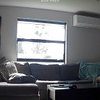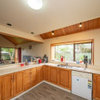Quartz thickness
I am in the process of ordering my countertop. I got a quote for a quartz counter which is 2cm thickness and will be built up with a 4cm edge. I also have an option to pay slightly more for the 3cm thickness. Am I crazy or will you not notice the difference because they will both have 4cm edges??
THANKS IN ADVANCE!!!
Comments (36)
Home Reborn
7 years agoYou won't notice the difference. Every counter on every one of my projects has been done with 2 cm (i.e. 3/4") stone.
Emily thanked Home RebornKathi Steele
7 years agoHere is a good discussion
[https://www.houzz.com/discussions/granite-countertops-2cm-vs-3cm-dsvw-vd~206211[(https://www.houzz.com/discussions/granite-countertops-2cm-vs-3cm-dsvw-vd~206211)
And another one....
https://www.alliedstoneinc.com/choosing-the-correct-slab-thickness
So, what it sounds like is the 2cm has to have a plywood layer below it so it will be strong enough. Also, be sure and research metal supports for overhangs.
km kane
7 years agoBuilders will use 2cm and do an edge because it's cheaper for them. They use plywood under it for thickness and strength. I'd never buy 2cm, go for 3cm. It's stronger, you won't see an edge, and you won't have problems with a slide in range fitting flush with the counter tops. Also, why do you want a 4cm outside edge? 3cm is fine!WS Granite Tops
7 years agoWe always prefer the 3cm material. You won't have the seam on the edges, the material is stronger, less likely to crack and better to undermount your sink!
Its worth the extra cost.
Emily
Original Author7 years agoThanks everyone!
We have a 12" overhang and were told there is no difference in support whether we choose the 2cm or 3cm.User
7 years agolast modified: 7 years agoThat is an absolute lie. Different thickness of stone have different deflection capabilities before they break. Thinner stone is not as strong as thicker stone. In no case would I ever design any overhang without invisible steel supports at a minimum. You cannot idiot proof your life, and people are sue happy if you break the toe of their little precious. Much less their heads. The fact that their kid was the one standing on the overhang won't mean a hill of beans.
Kathi Steele
7 years agoThat information is wrong. You need to research this. You need steel supports under the overhang that tie into the cabinets.
According to the Marble Institute of America, you can safely overhang granite that is 1- 1/4″ thick up to 10″ without supports.
http://www.countertopbracket.com/Countertop-Support-Hidden-Standard-Plus-p/sp.html
Here is one of the support systems
http://www.countertopbracket.com/
Also, make sure your tile backsplash is up to code. If you have a heavy duty rangetop, you need a heavy duty backguard.
G S
7 years agoWe have 3 cm with no edge (not sure what that is or how it works) and we needed a support for an island overhang.Patricia Colwell Consulting
7 years agoFind a supplier who does not talk nonsense a 2 cm counter is 50% thinner than 3 cm and it does make a difference for an overhang, BTW get steel supports for the overhang not corbels I happen to like and eased edge with 3 cm. material no build up on the edge or fancy edge detail
kmkane123
7 years agoyup, you have wrong information. Do NOT buy 2 cm. Either use simple corbels or some kind of exterior or interior support for your overhang. Depends on what they style of your room is.
Kathi Steele
7 years agoHome Reborn, according to the Marble Institute of America.....
In designs
where the countertop is cantilevered or
overhanging the supports, the cantilever shall
be limited to 6" (150 mm) for ¾" (20 mm)
thick countertops and 10” (250 mm) for 1¼"
(30 mm) countertops, but in no case may the
cantilevered portion represent more than
1/3 of the width of the countertop.
http://www.marble-institute.com/default/assets/File/consumers/homeownersconsumer_countertop.pdf
Home Reborn
7 years ago@ Kathi Steele -that is for unsupported cantilevers. There is always plywood under mine.
Kathy Okonske
7 years agoWe always use 3cm in all stones. We don't even sell the 2cm. No issues with install or sink installation. It always seems like the better buy and can be resold as a full stone countertop not a built up one. For supports we use Counter Balance Supports that are all metal for either the top of the cabinets or knee walls. I have done an 18" overhang with these and the fabricator loved them. No worries for install. Go for the 3cm. It will be worth it.
Joseph Corlett, LLC
7 years agolast modified: 7 years agoHome Reborn:
The OP's question was on quartz, not granite. There the authority is the quartz manufacturer. Most quartz manufacturers allow 3cm to be cantilevered up to 14" without additional supports. This is because quartz has much more flexural strength than natural stone.
See page 20 of the Caesarstone manual, please,
If you ever get a callback on any of the scores of improperly supported 2cm you've installed, you've got no warranty coverage.
User
7 years agolast modified: 7 years ago@ everyone that is jumping on the supplier/fabricator without ANY facts.
Emily said;
"Thanks everyone!
We have a 12" overhang and were told there is no difference in support whether we choose the 2cm or 3cm."
.
WHERE IN THIS STATEMENT DOES IT INDICATE THAT THEY ARE NOT USING ANY SUPPORT?? The statement simply suggests that they are using the same support method for either thickness.... which may even be more than the manufacturer recommends, for all we know.
User
7 years agoResin breaks too. Especially when that 100 pound 12 year old is all of a sudden a 240 pound 14 year old football player still sitting on the counter like he always did. Otherwise, my old desk wouldn't have had a giant crack in it. The only reason it didn't fall was the plywood underlayment and steel post. And that is Corian, which mostly resin with aluminum trihydrate and not half as heavy as stone with resin.
User
7 years agolast modified: 7 years agoI can pretty much break everything in your house if I bring my skid-steer over, including a concrete patio. That doesn't make it a bad design. If designing a house required making it safe for the IQ of Sophie's acquaintances, NO house would pass. I suppose you would blame the car if he jumped up on the hood and dented it? Or the chair at school because he was leaning back in it? 5/8 type X gypsum isn't even enough to keep renters from putting holes in the walls of my rentals, but I am not about to pour all the walls with concrete!
Obviously, Caesarstone does not agree with you. If a contractor had to design for your criteria, the cost of the house would be twice as much as every other builder, and that builder would never get a first job, let alone make a living at it.
Emily
Original Author7 years agoThanks everyone for your comments! I ended up calling the manufacturer and sorted out the overhang situation - they said there is no extra support required for up to 12" overhang for 2cm thickness and up to 16" overhang for 3cm thickness.
This did however lead me to another question I'm hoping you guys can help me out with - what does the underside of the overhang typically look like? I'm worried if we do go with the 2cm that you will see plywood underneath? I want to see the countertop surface underneath as well...Joseph Corlett, LLC
7 years agoWho's looking underneath? Unless you have a sunken living room and can see under the counter overhang from the sofa, this shouldn't be an issue.
kmkane123
7 years agoof course you can see underneath! I'm sitting in an easy chair and can see the bottom of my kitchen island overhand right now.
And geesh Fred, we love your answers you are very knowledgeable, but why so mean? Sophie's got a good point there.
User
7 years agoSteel countertop braces add approximately $300 to most of my jobs. That is material and labor. That is less than a typical sink on the job. I use them even if there are decorative corbels. It is better to have a cheap insurance policy than none at all. There are simple, inexpensive, best practices that any Professional does on a job, regardless of if mandated by code, or manufacturers requirements.
Home Reborn
7 years ago@Joseph Corlett - I take issue with the suggestion that any counters that I (or should properly say, my counter fabricator) have installed have been "improperly supported." As the Caesarstone manual says, "no additional support" is required on 2 cm material for up to a 12" overhang with plywood support underneath.
Moreover, 15 years of installations with zero issues surely counts for something....
Home Reborn
7 years ago@Emily - you shouldn't be concerned whether you see plywood on the underside of your counter overhang because the bottom side of any solid surface counter material is unfinished and unpolished anyway; i.e., plywood is no worse to look at than the counter material itself. And in any event you can always paint it black to make it disappear somewhat.
Joseph Corlett, LLC
7 years agoHome Reborn:
Sorry if I misinterpreted your post. If you used 5/8" plywood and cantilevered up to 12", you are within Caesarstone's specifications.km kane
5 years agoAnd your point Debbie? Manufacturers make countertops into centimeter and 3 cm not in 1 1/4 inches. Who is ever talking about 1 1/4 inches anyway? 2 cm if you want to get it cheaper and can live with the seam on your outside edge, 3 cm if you don’t and you want more strength. Also notice in this thread it’s mostly the builders defending 2 cm. Not only is it cheaper, they can as one commentor said install other parts of the kitchen while waiting for the solid surface top to come inJoseph Corlett, LLC
5 years ago3cm = 1.18 inches. 1 1/4" = 1.25", so technically 1 1/4" is thicker than 3cm by .07".
Joseph Corlett, LLC
5 years agoFor some reason, 2cm is used west of the Mississippi, and 3cm east thereof. It's a regional thing.
Sinks held in place by plywood seems a horrible idea to me; a nightmare to replace. The guys out west have to repair rods from the top, whereas I can pull them out the bottom, much faster and more inconspicuously.
Excepting cantilevers, there is no structural reason to use full plywood underlayment on stone or estone, but there is tremendous economic pressure on fabricators to cut costs and use roofing underlayment instead of cabinet grade plywood. You want to decrease, not increase, the amount of dissimilar materials having to work together.Skyblu Design
2 years agolast modified: 2 years agoI realize that this is an old post, but I hate that you can see the plywood underneath the cantilivered edge. My quartz was 3/4" with a mitered square edge making it look like 1.5". My installer used a cheaper, splintered plywood, so that when sitting at the counter, the splinters would snag my clothes. As a bandaid fix, I had him come out, sand the plywood and paint it white (matching the white cabinets). For the next project I did, I used a much better grade of plywood (no splinters, really smooth) and that worked better. Then for the project after that, I had a matching-the-cabinet skin applied on top of the plywood. And, for another project, a vinyl skin was glued on top of the plywood during installation. If affordable, I would prefer to use the 1.5" quartz, rather than the 3/4" quartz (no plywood needed), so that you have the quartz on both sides (on top and underneath).




Home Reborn